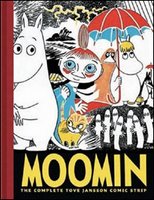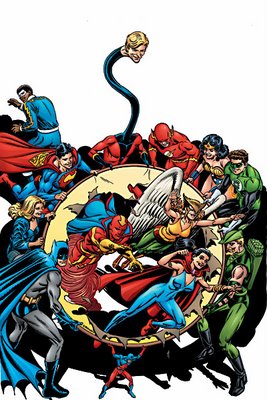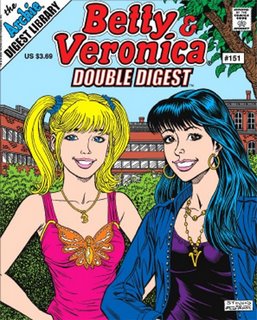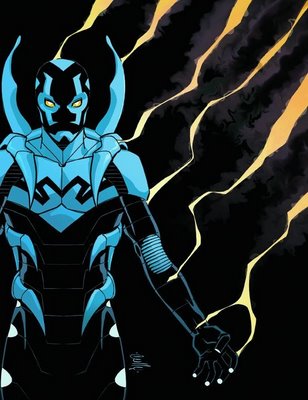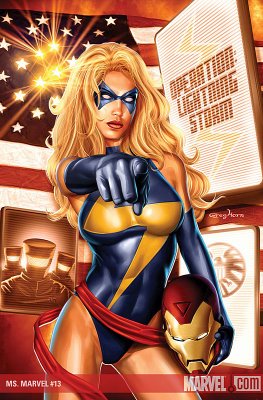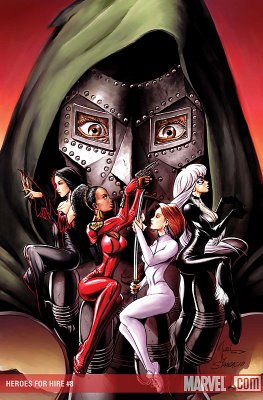
Last week’s
52 origin was probably the most infuriating of the lot, as it only underscored the nebulous nature of continuity post-
Infinite Crisis (i.e.,
no one seems certain of what is and isn’t considered canon anymore), and the “Essential Storylines” suggestions were so off-base that DC seemed to be doing it on purpose.
The subject was Martian Manhunter, who, like fellow Superman-esque caped strong man Captain Marvel, was forced into a bizarre new direction for no real reason in the wake of
Infinite Crisis. The entire two-page, eight-panel story has been posted online, and you can follow along
here.
The art is provided by Tom Mandrake, the primary artist for the short-lived (but exceptional)
Martian Manhunter monthly series, and follows the by now familiar pattern of a splash panel of the hero’s current look, a re-telling of the origin, a one-panel recap of where we left them and a head-shot.
So Mandrake draws J’onn as he’s recently appeared, wearing his new body suit and his new head shape, which is neither his superhero head or his private Martian head, but an entirely new amalgation of the two, one which bears an unfortunate resemblance to Marvel’s shape-shifting, green-skinned alien race.
That’s followed by panels retelling of the plague that killed all the green Martians save J’onn, his abduction by Earth scientest Erdel, and his adoption of a secret identity.
Then things get weird. One panel tells of his finding kinship with the JLA, and the image shows the five founders, the four boys plus Wonder Woman. Pre-
Crisis on Infinite Earths, Wonder Woman founded the League with J’onn, Aquaman, Flash and Green Lantern. After the multiverse collapse of
COIE, however, Wonder Woman didn’t debut in “Man’s World” until shortly after the
Crisis, and Black Canary was retroactively made a stand-in for Wondy.
When
Infinite Crisis re-created and re-collapsed the multiverse, forming “New Earth,” it was revealed Wonder Woman was a founder again, which negates about half of her own stories since George Perez relaunched her title in the ‘80s, and threw JLA history into confusion. Does she now replace her replacement Black Canary? Or are there now six founders, with both her and Black Canary founding the League alongside the boys?
We didn’t know, and this is the first time the topic has been addressed. But even this seemingly straightforward answer would be contradicted immediately (see below).
The final panel shows J’onn shapeshifting into his new costume and skull-shape, with the narration telling us, “He has re-embraced his Martian form in hopes of drawing others to him” in reaction to ignoring his “native heritage.” This strikes me as an essentially immature move on J’onn’s part, considering he’s been on earth for about 50 years now, at least ten of those years in his familiar shape. If anything, the radical change at this point in his career seems like a sort of mid-life crisis, like someone turning 50 and deciding to get his ears pierced or plastic surgery.
But lets turn our attention to the nuttiest part of the origin story, the “Essential Storylines.”
Here’s what DC suggests…
JLA: YEAR ONE: In case you, dear reader, have not read this story, it was a 12-issue maxiseries by Mark Waid and Barry Kitson that spun out of the Grant Morrison, Howard Porter and John Dell
JLA series, recounting the formation of the Justice League—by Black Canary! It’s an excellent, character-driven story, one that weaves inter-character conflicts between post-
Crisis reinterpretations of the classic Silver Age Justice League stories. Now, if Wonder Woman founded the League instead of Black Canary, this entire story is essentially irrelevant and out of canon now. By all means, read it for it’s great art and Waid’s clever takes on DC second-tier heroes and the universe’s history, but the panel on the very same page that recommends it also tells us not to bother with it, as it doesn’t “count” anymore.
JUSTICE LEAGUE OF AMERICA #144: This is a puzzling inclusion, as it was a story that was also knocked out of continuity during
COIE. Essentially a retcon of the original Silver Age origin story about the Apellexian invasion encouraging the seven heroes to band together to defeat threats too big for any of them to handle solo, this issue featured Green Arrow discovering the League’s
true origin story, which involved rescuing Martian Manhunter from other Martian forces (a story riffed on in the animated
Justice League series.

Superman, Batman and Wonder Woman participated in this adventure, but this was a pre-
Crisis story. An issue of
Secret Origins,
JLA: Year One and the
Martian Manhunter monthly would all contradict this story. Post-
Infinite Crisis, one of the major contradictions (Black Canary now standing in for Wonder Woman) would be removed, but there still shouldn’t be any other Martians around, unless that too was changed. But even if this pre-
Crisis story, which has never been retold and has never been collected into a trade (meaning the only readers who know it are those who were reading
JLoA waaaay back in1977), is suddenly canon again, why recommend
JLA: Year One on the same list?
FORMERLY KNOWN AS THE JUSTICE LEAGUE: Now
this is a puzzling inclusion. This six-issue miniseries by Keith Giffen, J. M. De Matteis and Kevin Maguire, reunited many of the principles from the old JLI era of the 1980s as “The Superbuddies,” but Martian Manhunter was not one of them. In fact, J’onn has a few panels worth of cameo in #5, and guest stars along with fellow Leaguers Wonder Woman, Batman, Flash and Plastic Man in #6, but it hardly amounts to a Martian Manhunter storyline, let alone an essential one. More essential might be, oh, any Justice League story from the 20 years or so between the “Detroit League” era on to
JLA: World Without a Justice League or any issue of
Martian Manhunter.
COUNTDOWN TO INFINITE CRISIS: This is another puzzling inclusion. True, J’onn J’onnz appears (along with just about every other active DC superhero), but for little more than a cameo. In fact, he gets fewer lines and less panel time here then he did in
Formerly Known as the Justice League. And what little of J’onn we see here is not flattering. He’s shown in the JLA’s Watchtower headquarters, blowing off his long-time friend and ally Ted “Blue Beetle” Kord, who has unlocked a conspiracy that will plunge the world into the chaos of
Infinite Crisis, but J’onn doesn’t even give this long-time Leaguer a little eye contact, instead focusing on taking calls from Hawkman, Hawkwoman and Adam Strange. Blue Beetle then goes off on his own and gets himself killed.
The inclusion of this story is also interesting because it’s another one that is directly contradicted by a story on this list.
Formerly Known As the Justice League is all about how the cyborg Max Lord gathers his friends Blue Beetle, Booster Gold and others to form a store-front super-team known as The Super Buddies. In
Countdown, the now human Max Lord is an evil Bond-style villain bent on world domination, one who puts a bullet in Beetle’s head.
And here’s what they missed…
THE JUSTICE LEAGUE: J’onn J’onnz’s record with the Justice League is unrivaled, and he’s done more time with the team than any other character.
He founded the League with Aquaman, the Silver Age Green Lantern and Flash Barry Allen, and either Wonder Woman or Black Canary, depending on what side of which crisis we’re talking about the League’s founding on. And unlike his fellow founders, he never really quit or got killed off, staying with the team right up until the present, only taking occasionally leaves of absence (like a rather substantial one during the “Satellite Era”).
The League’s original adventures are collected in
Showcase Presents: Justice League Vol. 1, in which J’onn still looked like a green bald man and lacked his mental powers of telepathy and, seemingly, the ability to change shape or become intangible. At the time, his “Martian vision” was apparently some sort of ill-defined extra-sensory device, rather than his version of Superman’s heat vision.
The story of the League’s founding was re-told in the previously mentioned
JLA: Year One, although
Infinite Crisis seems to have erased it from the canon. Other now questionably canonical tales of this time period appear in
JLA: Incarnations #1 and #2 (in fact, J’onn’s the only Leaguer to appear in all seven issues of the series).
J’onn joined Aquaman, Elongated Man and Zatanna in leading a new generation of heroes consisting of Vixen, Vibe, Steel and Gypsy in the short-lived “Detroit Era,” which was recently revisited in the poorly-written but well-drawn
JLA: Classified arc, “A Game of Chance” (#22-#25…don’t hold your breath waiting for a trade).
After
Crisis on Infinite Earths and
Legends, J’onn was present for the formation of a new Justice League, this one consisting of Blue Beetle, Mister Miracle, Dr. Fate, Black Canary, Captain Marvel and Green Lantern Guy Gardner, all led by Batman.

When the team officially accepted sponsorship by the United Nations, Batman surrendered leadership to J’onn, who he explained was, “the one person really
qualified to command an international League is the only one of us who really sees this planet as a unified
whole.” J’onn became the League’s leader for the entirety of the JLI era, an era that is woefully unrepresented in trades, and only a single one was published,
Justice League: A New Beginning. Under writers Keith Giffen and J. M. DeMatteis, J’onn would develop a real personality, often playing straight man to the comedians on the team, and the father figure to the family the League was becoming. He also began his habit of eating Oreos at this time (later changed to “Chocos” over trademark issues).
When Giffen and DeMatteis finally ended their historic run on the Justice League books,
JLA’s new writer Dan Jurgens found a way to have J’onn be both on the team and not on the team at the same time (Um, spoiler warning…?).
Later, the Manhunter would find a home in
Justice League Task Force, which began as a book featuring rotating writers assembling rotating teams of Leaguers, assembled for specific missions. Usually, it was J’onn and Gypsy plus others. Halfway through the book’s run, when the League splintered into factions led by Wonder Woman, Captain Atom and J’onn, J’onn’s team was the Task Force, and writer Christopher Priest gave J’onn a team consisting of The Ray II, Triumph, Gypsy and L’Ron-in-Despero’s-body.
This League came to and end as Grant Morrison, Howard Porter and John Dell’s
JLA was on the horizon, with
Total Justice,
Justice League: A Midsummer’s Nightmare and
JLA: New World Order spelling the transition from several Leagues of minor heroes to a return to the Silver Age “Big Seven” formula.

In the process of repelling a White Martian invasion (another nod to
JLoA #144), J’onn joined Superman, Batman, Wonder Woman, Aquaman, the Flash Wally West and new Green Lantern Kyle Rayner as the new JLA. Morrison’s entire run (Six volumes, from
New World Order to
World War III, plus
JLA: Earth 2 and
DC One Million) is required reading, of course, but the most J’onn centric storyline is probably the first one, although his most bad-ass moment would come in his effortless takedown of Ultraman in
Earth 2.
Morrison’s run was followed by a short one by Mark Waid, who played with J’onn’s human alter ego in
JLA: Divided We Falland returned the White Martians in
JLA: Terror Incognita, and then Joe Kelly, who gave J’onn a love interest, leave of absence and star turn as a villain in
JLA: Trial By Fire, in which we learn why Martians are better off
not conquering their fear of fire, and how deadly a foe J’onn could be (Kelly also killed off all the White Martians here).
JLA lost it’s focus at this point, shifting from one creative team to another, but J’onn remained front and center for most of the stories, including Kurt Busiek’s “Syndicate Rules” and the various
JLA: Classified storylines, up until “Crisis of Conscience,” in which we learn that the so-called “Power Pact” betrayed J’onn as well.
The relaunched Justice League title, Brad Meltzer, Ed Benes and Sandra Hope’s
Justice League of America is on it’s fifth issue, and there’s been no mention of J’onn so far; he’s not on the current line up of the team.
MARTIAN MANHUNTER, SOLO: J’onn’s had several chances to fly solo over the years, not counting his Silver Age back-up stories in titles like
Detective Comics, but only those in his monthly could really be considered “essential” (1992 prestige format miniseries
Martian Manhunter: American Secrets by Gerard Jones and Eduardo Barreto had it’s moments, though).
Taken as a whole, John Ostrander and Tom Mandrake’s
Martian Manhunter is probably
the essential Martian Manhunter series. Spinning out of Morison, Porter and Dell’s
JLA at the height of it’s popularity, the former
The Spectre team would tell J’onn’s tale almost as consummately as they did old Moonface’s, though the series seemed to struggle to find a status quo, and was cancelled after 36 issues and two annuals (plus a #0 issue and a #1,000,000 issue).
Still, Ostrander made great use of the wide canvas of the DCU and accentuated that which made J’onn unique, synthesizing various takes on and incarnations of the character. He gave Mars a language, a religion, a history and a culture, and had J’onn live it; he made perfect sense of the on-again, off-again Martian vulnerability to fire; he made some stumbling attempts at giving J’onn a unique rogue’s gallery, refashioning Darkseid and Kanto as recurring villains; he introduced us to the post-
Crisis Zook; he established J’onn as the most popular superhero of the Southern hemisphere and Third World; he gave J’onn multiple secret identities through which he could better explore humanityl and he even got J’onn laid.
DC hasn’t collected any of the series, which is a damn shame. The #0 issue thoroughly re-tells J’onn’s origin, and is immediately followed by an epic confrontation with the
other last surviving Martian, Malefic that runs between #1-#9 (This is essentially a JLA story, and thus would be a good place for a trade collection to start). Also of particular relevance are the storylines “The Rings of Saturn” (a Sci-Fi space opera about the relationship between J’onn and J’emm, and the Martians and Saturnarians which ran through #13-#16), “In My Life” (and adventure set on Mars and running through #33-#36, with art by Barreto) and “Revelations” (a series of one-shots set in J’onn’s past and covering his first meetings with Batman, Superman, The Spectre and Green Lantern Abin Sur, plus a humorous JLI homage dealing with a Blue and Gold practical joke gone horribly wrong). In addition to these characters and his JLA colleagues, much of the DCU would pass through the pages of Ostrander’s
Martian Manhunter at some point, like Fire (#10, drawn by Phil Winslade), Swamp Thing and the Legion (in #11, drawn by pre-
Ultimates Bryan Hitch), dead Leaguers Vibe, Crimson Fox, Steel and Ice (#12), Chase and Director Bones (#17), the JSA (#18 and #19) and Gypsy (#12 and #25).
That series was J’onn’s last solo outing until the launch of his current miniseries, the one in which he dresses funny and has a Skrull skull. I only read the eight-page prelude in
Brave New World and the first issue, which is about all I could stand of the ridiculous new direction, sub-par writing and so-so art. I expect this direction to be even shorter-lived than the current Shazam-ification of Captain Marvel; the only other appearances of the “New Look” Martain Manhunter have been in
Superman/Batman, where J’onn tells Batman he’s invulnerable to flame again (contrary to what this origin story in
52 tells us), and we’re introduced to “New Earth” Zook, who is the same as pre-
Crisis Zook, only more of a dick.
MARTIAN MANHUNTER CRISIS: In 1986 crossover series
Legends, written by John Ostrander and Len Wein and drawn by John Byrne and Karl Kesel, Darkseid launches a propaganda campaign against Earth’s heroes. J’onn leads Firestorm and the Detroit League against Apokalyptian giant Brimestone at the outset, and they get slaughtered. He pops up again at the end, as part of an impromptu League assembled by Dr. Fate, one which includes Superman, Batman, Black Canary, Green Lantern Guy Gardner, Flash, Changeling, Blue Beetle and Captain Marvel (now
that would be an interesting JLA line up!). At one point, J’onn saves President Ronald Reagan’s life by using his abilities to pose as the Commander in Chief, taking a fatal blast in his rock hard Martian abs, then punching his assailants out…while still in Regan’s form! (Hope they got footage of that to run in his future campaign ads). The series ends with J’onn and some of the others deciding to form a new League, one which would become the JLI.
In 1987, weekly crossover series
Millennium would introduce the
New Guardians, one of several failed attempts to create a new generation of superheroes in a company-wide crossover (see also
Bloodlines and
Planet DC, of which Tommy “Hitman” Monaghan seems to have been the only one to break out and do something with himself). Today the Steve Englehart script seems horribly dated and hard to read, and the series is most notable for it’s snapshot of the DCU at the time, although I did enjoy seeing all that lovely Ian Gibson art on the DC heroes. J’onn appears, of course, and is sent to the Manhunter homeworld, along with other space-worthy heroes like the Green Lanterns, the Hawks, Superman, Firestorm and Captain Atom. This is another crisis not available in trade.
In 1988, a trilogy of ad-free 80-page giants told the core story of
Invasion!, in which an alliance of aliens led by the Dominators sought to take over the planet. Despite the fact that the story stars the entire DCU of the late 80’s and the fact that the first half of it is penciled by Todd Fucking McFarlane (and the rest of it by Bart Sears and Keith Giffen, with P. Craig Frigging Russell on inks), the book is uncollected in trade form. J’onn gets a few pages of the McFarlane treatment, but plays his biggest role in the final book, in which he joins a squad of heroes consisting of Superman, Robotman, Hal Jordan and Guy Gardner in an invasion of the Dominator homeworld to find a cure for the Metagene bomb that’s threatening to kill all the heroes (Spoiler alert! They succeed).
The same year also saw the release of the Jim Starlin written, Mike Mignola penciled miniseries
Cosmic Odyssey, in which Darkseid and Highfather enlisted J’onn along with Batman, Superman, Green Lantern John Stewart, Adam Strange, Etrigan the Demon, Starfire, Orion and Lightray to beat back an invasion by the sentient Anti-Life Equation. J’onn teams with John, and the latter fucks up, the former engaging in some harsh words with him that climaxes in a hell of final confrontation between the two. It’s been collected into a
trade I’d highly recommend to anyone jonesing for some New Gods or Mignola fans who’d like to see what he’d do with DC’s big guns.
J’onn’s place in the League guaranteed at least a cameo in each of DC’s future crossover stories. He’d face a possible future in
Armageddon 2001, journey to the moon to fight Eclipso in
Eclipso: The Darkness Within, journey to hell to face Neron in
Underworld Unleashed, fight off the Parasites before falling to The Taker in
Bloodlines: Bloodbath, become something god-like in the far-flung future of
DC One Million, fight a Joker-ized Dr. Polaris in
Joker’s Last Laugh and an Imperiex probe in
Our World’s At War.
After getting sucker-punched in an attack by Superboy-Prime that leveled the League’s Watchtower, J’onn spent most of
Infinite Crisis chained up in Alexander Luthor’s weirdo Anti-Monitor corpse tower, reviving at the end.
J’onn was pretty busy during the first half of the missing year currently being chronicled in DC’s weekly series
52. He appears in #24, and we learn that he’s been using his shape-changing and mind-reading abilities to systematically dismantle Checkmate to avenge Blue Beetle (and atone for blowing him off), a four-page sequence that proves infinitely more interesting than the whole first issue of his current miniseries.
MARS, AND OTHER MARTIANS: Under appreciated 2005 six-part miniseries
Son of Vulcan, by Scott Beatty and Keron Grant, featured White Martian A’monn A’mokk as it’s Big Bad. He was part of a pair held in reserve on “breeding duty” during the last invasion, but when his mate was killed he’s forced to resort to fertilizing his eggs with stem cells taken from members of the Secret Society of Super Villains, which result in five Martian/human hybrids.
SOV #5 features a lengthy section about the origin of the Vulcans, a line of fire-weilding heroes created specifically to defend earth from White Martian invasion.
The undead hero of
Seven Soldiers: Frankenstein follows his foes through an “Erdel Gate” to the red planet in #2 of his four-part miniseries. We don’t see any Green or White Martians there, but we do see some Martian architecture and some of the other indigenous life forms, like the giant, insectoid “man-eating mares of Mars.”
Finally, a new Martian heroine was introduced in the pages of
Teen Titans, a green-skinned, red-haired, sailor-suit wearing girl who goes by the name Miss Martian. She’s soon revealed to be a White Martian, wearing a more socially acceptable form. She made her first appearance in the “Titans Around the World” storyline, and has since appeared in
52 and joined the Titans.
OTHER UNIVERSES: The Manhunter’s awesome powers make him something of a stumbling block for a lot of writers to deal with, particularly when they’re looking to destroy or radically remake the DC Universe in “Elseworlds” stories set outside of continuity/canon.
In the DKU, for example, J’onn appears in
The Dark Knight Strikes Again as a broken down shell of a man—er, Martian—who has lost his powers (and who is killed off shortly after introduction).
In the
Kingdom Come-iverse, he’s similarly broken down, with the explanation being he overreached with telepathy in an attempt to contact too many minds at once and thus lost his own mind.
Alex Ross found better use for J’onn in the Ross-iverse, however, as the green-skinned Superman played prominent roles in
JLA: Liberty and Justice and the ongoing maxiseries
Justice, the latter of which makes sharp distinctions between J’onn and similarly powered Superman and Captain Marvel.
Darwyn Cooke’s series
The New Frontier, which posits a world where the characters introduced in DC’s Silver Age starred in an adventure that actually occurred in the 1950s and 1960s, is hands down one of the best Martian Manhunter stories of them all (just as it’s one of the best Hal Jordan stories).

Stranded on Earth, J’onn learns about our culture via the television, then utilizes his shape-shifting abilities to become a private eye, fighting crime and seeking bizarre mysteries in Gotham City. Eventually, he’s taken captive by the U.S. government, and strikes up a friendship with King Faraday. Cooke manages to use all three of J’onn’s looks effectively, and his take on the character’s origin, design and characterization should be mandatory reading for anyone hoping to write the character in the future.
OTHER MEDIA: J’onn J’onnz got the shaft when the JLA came to Saturday morning cartoons in the late seventies as
The Superfriends, and didn’t make the cut on any of the incarnations of that show.
In the mid-90’s, he was one of the characters to appear in the pilot for a Justice League live action TV show that was influenced by the JLI Era of the team. Luckily for JLA fans (if not for Martian Manhunter’s mainstream profile) no one saw fit to make an actual series out of it.
He fared far better in the 21st century, being one of the seven heroes to make up the team starring in
Justice League (even beating out Aquaman, who was relegated to guest status). In both the
Justice League and
Justice League Unlimited, J’onn was the team’s de facto leader and factotum, hanging out on the Watchtower all day and playing switchboard operator. In the final leg of the show’s run, that role was taken over by Mr. Terrific, as J’onn adopted a human guise to get to know humanit better. But the damage was done: The Martian Manhunter was a household name at last, earning his own toys and coloring book and T Shirt appearances.
